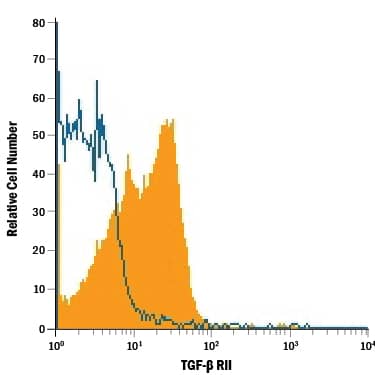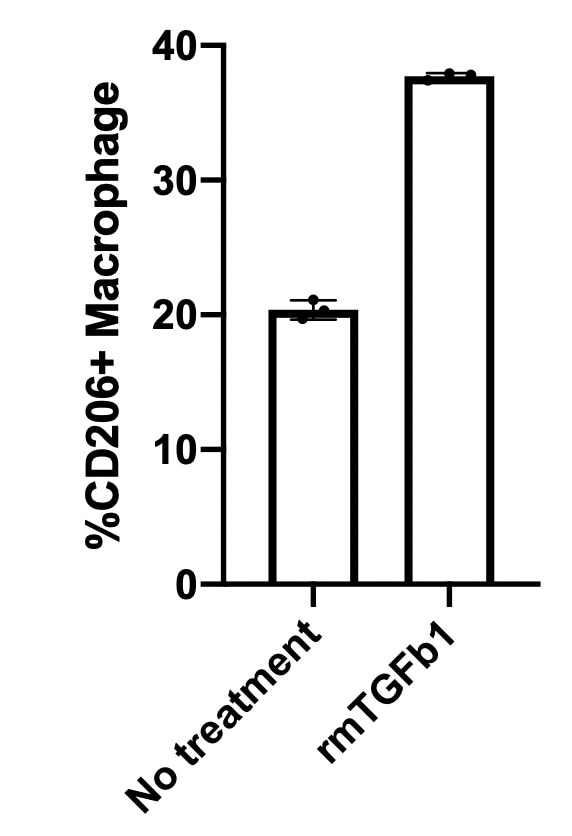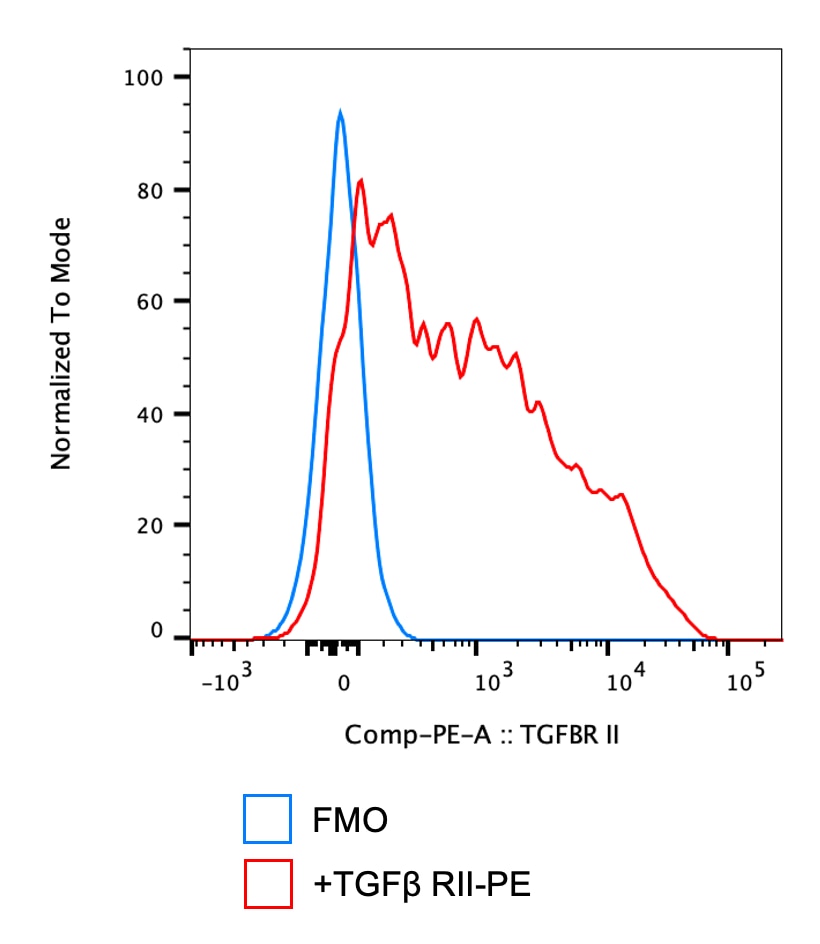Mouse TGF-beta RII PE-conjugated Antibody Summary
Ile24-Asp184
Accession # Q62312
Applications
Please Note: Optimal dilutions should be determined by each laboratory for each application. General Protocols are available in the Technical Information section on our website.
Scientific Data
 View Larger
View Larger
Detection of TGF‑ beta RII in Mouse Splenocytes by Flow Cytometry. Mouse splenocytes were stained with Goat Anti-Mouse TGF-beta RII PE-conjugated Antigen Affinity-purified Polyclonal Antibody (Catalog # FAB532P, filled histogram) or isotype control antibody (Catalog # IC108P, open histogram). View our protocol for Staining Membrane-associated Proteins.
 View Larger
View Larger
Detection of TGF-beta RII PE by Flow Cytometry miR-21 silencing induces an antiinflammatory phenotype and upregulates TGF-beta –related pathway in macrophages. Macrophages transfected with an miR-21 antagomir (antagomir-21) or scramble control followed by RT-qPCR and flow cytometry. (A) miR-21-5p fold change in BMDMs after 48-hour transfection with antagomir-21 (n = 8). (B) Spry2 mRNA fold change in BMDMs after 48-hour transfection with antagomir-21 (n = 8). (C) Tgfb1 fold change in BMDMs after transfection with antagomir-21, n = 8 per group pooled from 2 independent experiments. (D) Spearman’s correlation between miR-21-5p expression and Tgfb1 mRNA expression (n = 11). (E) RT-qPCR of Tgfbr2, Tgfbr1, Tgfbr3, and Smad7 in BMDMs after 48-hour transfection with antagomir-21 (n = 8). (F) RT-qPCR of proinflammatory genes Tnfa and Il6 in BMDMs transfected with antagomir-21 (n = 8). (G) RT-qPCR of antiinflammatory genes Mrc1 and Il10, n = 8 per group, pooled from 2 independent experiments. (H) Flow cytometry analysis of TGF-beta R2 expression in BMDMs after silencing miR-21-5p, n = 4 per group. The bar graphs represent the percentage of F4/80+TGF-beta R2+ cells. Data are presented as mean ± SEM. *P < 0.05, **P < 0.01 by unpaired, 2-tailed Student’s t test (A–C and E–G). Image collected and cropped by CiteAb from the following open publication (https://pubmed.ncbi.nlm.nih.gov/37071481), licensed under a CC-BY license. Not internally tested by R&D Systems.
 View Larger
View Larger
Detection of TGF-beta RII PE by Flow Cytometry miR-21 silencing induces an antiinflammatory phenotype and upregulates TGF-beta –related pathway in macrophages. Macrophages transfected with an miR-21 antagomir (antagomir-21) or scramble control followed by RT-qPCR and flow cytometry. (A) miR-21-5p fold change in BMDMs after 48-hour transfection with antagomir-21 (n = 8). (B) Spry2 mRNA fold change in BMDMs after 48-hour transfection with antagomir-21 (n = 8). (C) Tgfb1 fold change in BMDMs after transfection with antagomir-21, n = 8 per group pooled from 2 independent experiments. (D) Spearman’s correlation between miR-21-5p expression and Tgfb1 mRNA expression (n = 11). (E) RT-qPCR of Tgfbr2, Tgfbr1, Tgfbr3, and Smad7 in BMDMs after 48-hour transfection with antagomir-21 (n = 8). (F) RT-qPCR of proinflammatory genes Tnfa and Il6 in BMDMs transfected with antagomir-21 (n = 8). (G) RT-qPCR of antiinflammatory genes Mrc1 and Il10, n = 8 per group, pooled from 2 independent experiments. (H) Flow cytometry analysis of TGF-beta R2 expression in BMDMs after silencing miR-21-5p, n = 4 per group. The bar graphs represent the percentage of F4/80+TGF-beta R2+ cells. Data are presented as mean ± SEM. *P < 0.05, **P < 0.01 by unpaired, 2-tailed Student’s t test (A–C and E–G). Image collected and cropped by CiteAb from the following open publication (https://pubmed.ncbi.nlm.nih.gov/37071481), licensed under a CC-BY license. Not internally tested by R&D Systems.
Reconstitution Calculator
Preparation and Storage
- 12 months from date of receipt, 2 to 8 °C as supplied.
Background: TGF-beta RII
Most cell types express three sizes of receptors for TGF-beta. These are designated Type I (53 kDa), Type II (70-85 kDa), and Type III (250-350 kDa). The Type III receptor, a proteoglycan that exists in membrane-bound and soluble forms, binds TGF-beta 1, TGF-beta 2, and TGF-beta 3 but does not appear to be involved in signal transduction. The Type II receptor is a membrane-bound serine/threonine kinase that binds TGF-beta 1 and TGF-beta 3 with high affinity and TGF-beta 2 with a much lower affinity. The Type I receptor is also a membrane-bound serine/threonine kinase that apparently requires the presence of the Type II receptor to bind TGF-beta. Current evidence suggests that signal transduction requires the cytoplasmic domains of both the Type I and Type II receptors.
The recombinant soluble TGF-beta Type II receptor is capable of binding TGF-beta 1, TGF-beta 3, and TGF-beta 5 with sufficient affinity to act as an inhibitor of these isoforms at high concentrations. The soluble receptor also binds TGF-beta 2, but with an affinity at least two orders of magnitude lower. Binding of TGF-beta 1, TGF-beta 3, and TGF-beta 5 to the soluble TGF-beta Type II receptor can also be demonstrated by using the soluble receptor as a capture agent on ELISA plates and this observation has been used as the basis for the development of immunoassays for these isoforms of TGF-beta.
Product Datasheets
Citations for Mouse TGF-beta RII PE-conjugated Antibody
R&D Systems personnel manually curate a database that contains references using R&D Systems products. The data collected includes not only links to publications in PubMed, but also provides information about sample types, species, and experimental conditions.
18
Citations: Showing 1 - 10
Filter your results:
Filter by:
-
TGF-beta signaling controls Foxp3 methylation and T reg cell differentiation by modulating Uhrf1 activity
Authors: Sun X, Cui Y, Feng H et al.
J. Exp. Med.
-
TCF-1 controls Treg cell functions that regulate inflammation, CD8+ T cell cytotoxicity and severity of colon cancer
Authors: A Osman, B Yan, Y Li, KD Pavelko, J Quandt, A Saadalla, MP Singh, M Kazemian, F Gounari, K Khazaie
Nature Immunology, 2021-08-12;0(0):.
-
Silencing miR-21-5p in sensory neurons reverses neuropathic allodynia via activation of TGF-beta –related pathway in macrophages
Authors: Lynda Zeboudj, George Sideris-Lampretsas, Rita Silva, Sabeha Al-Mudaris, Francesca Picco, Sarah Fox et al.
Journal of Clinical Investigation
-
Histone deacetylases facilitate Th17-cell differentiation and pathogenicity in autoimmune uveitis via CDK6/ID2 axis
Authors: Zhang, C;Liu, X;Gu, C;Su, Y;Lv, J;Liu, Y;Gao, Y;Chen, H;Xu, N;Xiao, J;Xu, Z;Su, W;
Journal of advanced research
Species: Mouse
Sample Types: Whole Cells
Applications: Flow Cytometry -
Semmaphorin 3?A causes immune suppression by inducing cytoskeletal paralysis in tumour-specific CD8+ T cells
Authors: Barnkob, MB;Michaels, YS;André, V;Macklin, PS;Gileadi, U;Valvo, S;Rei, M;Kulicke, C;Chen, JL;Jain, V;Woodcock, VK;Colin-York, H;Hadjinicolaou, AV;Kong, Y;Mayya, V;Mazet, JM;Mead, GJ;Bull, JA;Rijal, P;Pugh, CW;Townsend, AR;Gérard, A;Olsen, LR;Fritzsche, M;Fulga, TA;Dustin, ML;Jones, EY;Cerundolo, V;
Nature communications
Species: Mouse
Sample Types: Whole Cells
Applications: Flow Cytometry -
Kurarinone regulates Th17/Treg balance and ameliorates autoimmune uveitis via Rac1 inhibition
Authors: Gu, C;Liu, Y;Lv, J;Zhang, C;Huang, Z;Jiang, Q;Gao, Y;Tao, T;Su, Y;Chen, B;Jia, R;Liu, X;Su, W;
Journal of advanced research
Species: Mouse
Sample Types: Whole Cells
Applications: Flow Cytometry -
Progesterone attenuates Th17-cell pathogenicity in autoimmune uveitis via Id2/Pim1 axis
Authors: Liu, X;Gu, C;Lv, J;Jiang, Q;Ding, W;Huang, Z;Liu, Y;Su, Y;Zhang, C;Xu, Z;Wang, X;Su, W;
Journal of neuroinflammation
Species: Mouse
Sample Types: Whole Cells
Applications: Flow Cytometry -
Downregulation of Elovl5 promotes breast cancer metastasis through a lipid-droplet accumulation-mediated induction of TGF-beta receptors
Authors: TL Kieu, L Pierre, V Derangère, S Perrey, C Truntzer, A Jalil, S Causse, E Groetz, A Dumont, L Guyard, L Arnould, JP de Barros, L Apetoh, C Rébé, E Limagne, T Jourdan, L Demizieux, D Masson, C Thomas, F Ghiringhel, M Rialland
Cell Death & Disease, 2022-09-02;13(9):758.
Species: Mouse
Sample Types: Whole Cells
Applications: Flow Cytometry -
Intestinal CD11b+ B Cells Ameliorate Colitis by Secreting Immunoglobulin A
Authors: Ying Fu, Zhiming Wang, Baichao Yu, Yuli Lin, Enyu Huang, Ronghua Liu et al.
Frontiers in Immunology
Species: Mouse, Transgenic Mouse
Sample Types: Whole Cells
Applications: Flow Cytometry -
The induction and function of the anti-inflammatory fate of TH17 cells
Authors: H Xu, T Agalioti, J Zhao, B Steglich, R Wahib, MCA Vesely, P Bielecki, W Bailis, R Jackson, D Perez, J Izbicki, P Licona-Lim, V Kaartinen, J Geginat, E Esplugues, E Tolosa, S Huber, RA Flavell, N Gagliani
Nat Commun, 2020-07-03;11(1):3334.
Species: Mouse
Sample Types: Whole Cells
Applications: Flow Cytometry -
Downregulation of CXCL12 in mesenchymal stromal cells by TGF? promotes breast cancer metastasis
Oncogene, 2016-09-26;0(0):.
Species: Mouse
Sample Types: Whole Cells
Applications: Flow Cytometry -
TGF-? receptor maintains CD4 T helper cell identity during chronic viral infections
J Clin Invest, 2016-09-06;0(0):.
Species: Mouse
Sample Types: Whole Cells
Applications: Flow Cytometry -
Constitutive but not inducible attenuation of transforming growth factor beta signaling increases natural killer cell responses without directly affecting dendritic cells early after persistent viral infection.
Authors: Lewis G, Macal M, Hesser C, Zuniga E
J Virol, 2015-01-14;89(6):3343-55.
Species: Mouse
Sample Types: Whole Cells
Applications: Flow Cytometry -
Transforming growth factor-beta signaling controls the formation and maintenance of gut-resident memory T cells by regulating migration and retention.
Authors: Zhang N, Bevan M
Immunity, 2013-09-26;39(4):687-96.
Species: Mouse
Sample Types: Whole Cells
Applications: Flow Cytometry -
PARP-1 regulates expression of TGF-beta receptors in T cells.
Authors: Zhang P, Nakatsukasa H, Tu E, Kasagi S, Cui K, Ishikawa M, Konkel J, Maruyama T, Wei G, Abbatiello B, Wang Z, Zhao K, Chen W
Blood, 2013-08-12;122(13):2224-32.
Species: Mouse
Sample Types: Whole Cells
Applications: Flow Cytometry -
TGF-beta signaling to T cells inhibits autoimmunity during lymphopenia-driven proliferation.
Authors: Zhang N, Bevan MJ
Nat. Immunol., 2012-05-27;13(7):667-73.
Species: Mouse
Sample Types: Whole Cells
Applications: Flow Cytometry -
TGF-beta limits IL-33 production and promotes the resolution of colitis through regulation of macrophage function.
Authors: Rani R, Smulian AG, Greaves DR, Hogan SP, Herbert DR
Eur. J. Immunol., 2011-05-27;41(7):2000-9.
Species: Mouse
Sample Types: Whole Cells
Applications: Flow Cytometry -
Intestinal CD11b+ B Cells Ameliorate Colitis by Secreting Immunoglobulin A
Authors: Ying Fu, Zhiming Wang, Baichao Yu, Yuli Lin, Enyu Huang, Ronghua Liu et al.
Frontiers in Immunology
FAQs
No product specific FAQs exist for this product, however you may
View all Antibody FAQsReviews for Mouse TGF-beta RII PE-conjugated Antibody
Average Rating: 4.5 (Based on 2 Reviews)
Have you used Mouse TGF-beta RII PE-conjugated Antibody?
Submit a review and receive an Amazon gift card.
$25/€18/£15/$25CAN/¥75 Yuan/¥2500 Yen for a review with an image
$10/€7/£6/$10 CAD/¥70 Yuan/¥1110 Yen for a review without an image
Filter by:






